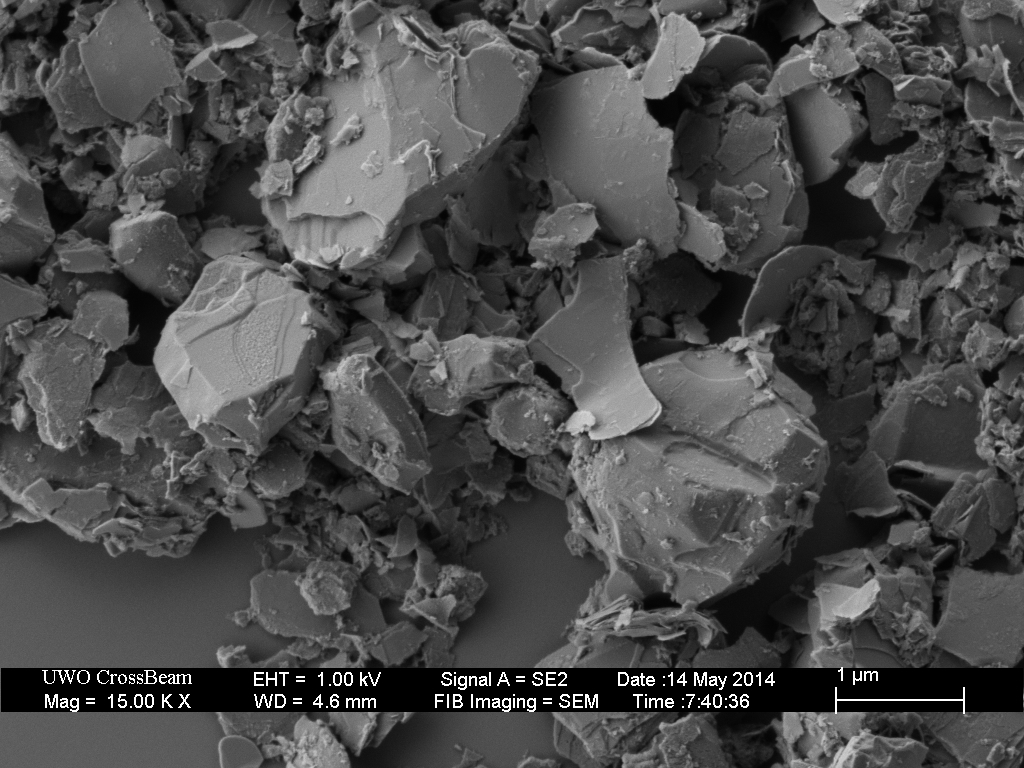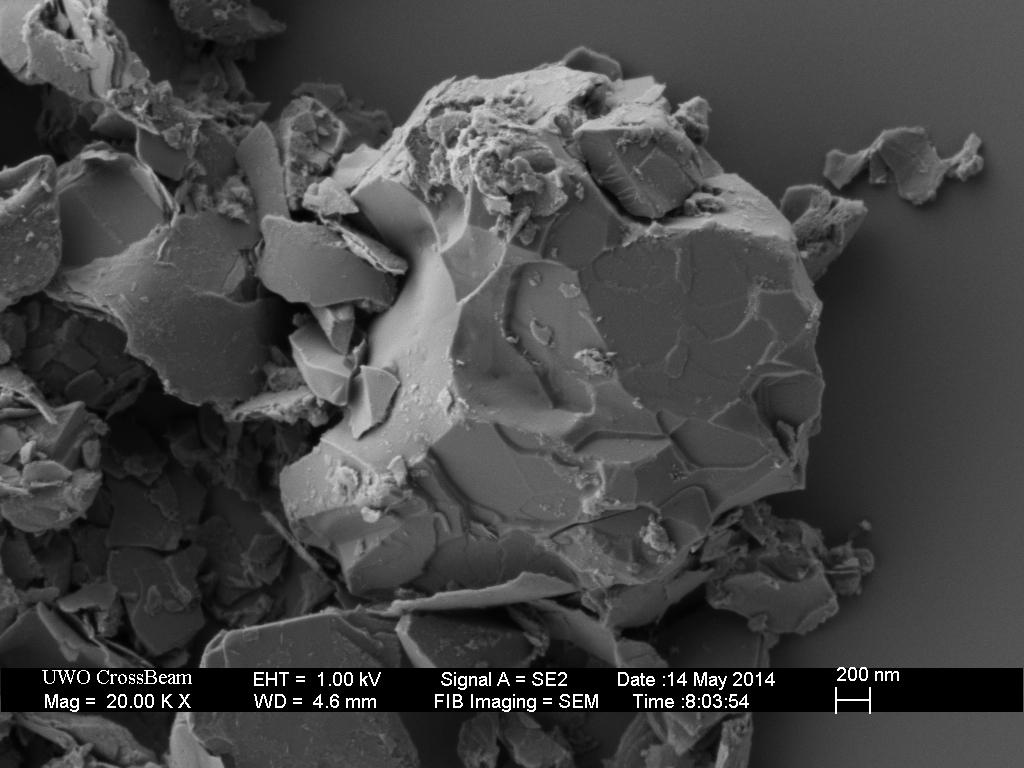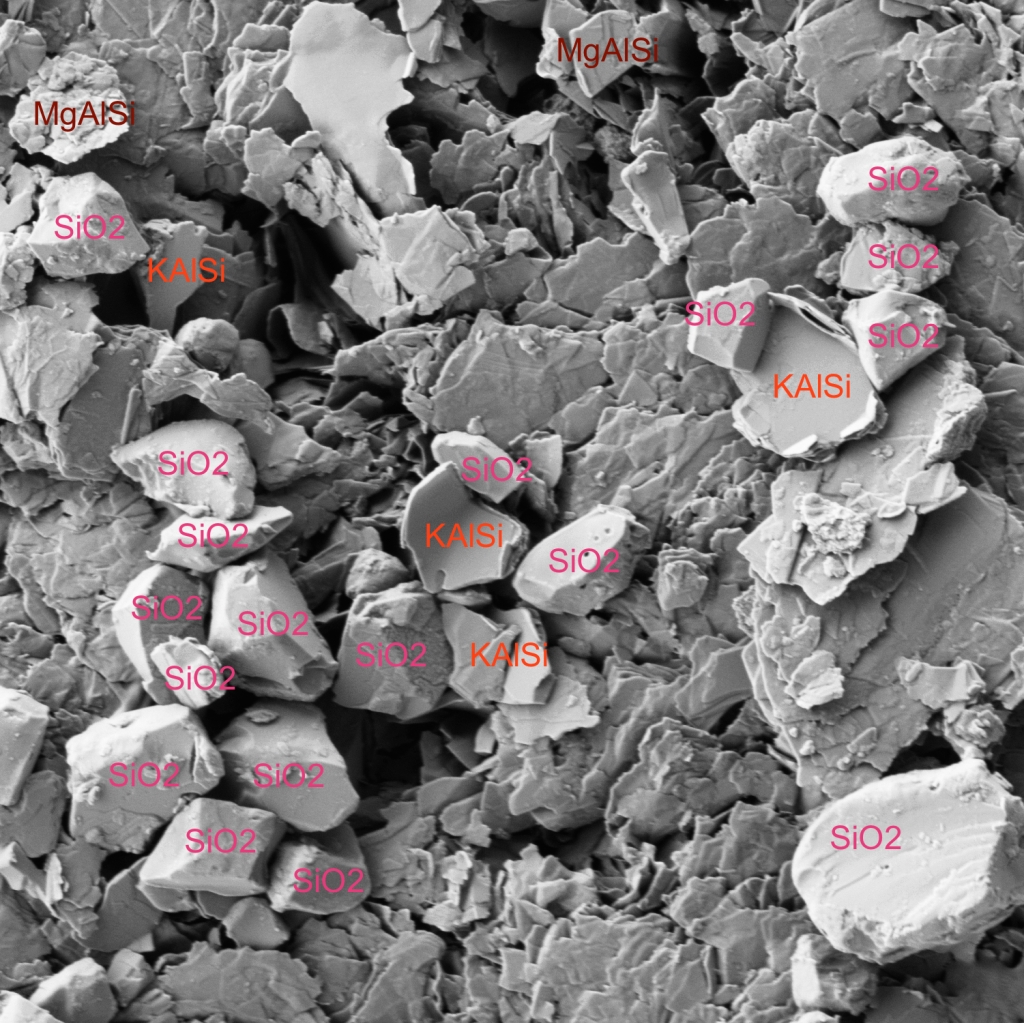Japanese Natural (JNat) whetstones are believed, by their devotees, to provide a unique honing experience. It is observed that the slurry changes character during use, supposedly “breaking down” into finer abrasive, and providing a transition from the initial grit to a finer grit.
To test this theory, slurry was produced on a Nakayama Asagi with a piece of the same stone (tomo). The slurry was captured and rinsed with DI water.
A second slurry was produced in an identical fashion, this one was “worked” by honing a carbon steel razor for approximately ten minutes. The slurry turned black with swarf during this time. The slurry was also captured and rinsed in DI water.
Each slurry sample was deposited onto a piece of polished silicon (featureless background for imaging) and images were taken of each sample.










To interpret the images above, we need to identify the different types of slurry particles. This analysis is accomplished within the SEM using EDX (Energy Dispersive X-ray Spectroscopy).

X-ray maps show the composition of each particle.






The data show 3 predominant types of particles; Silicon Oxide (silica or quartz) and two types of silicates; Potassium Aluminum Silicate, Magnesium Aluminum Silicate. A small number of Iron-containing silicates and iron oxide are also visible. A part of the above image is annotated, below, showing various particle identities.
The image and corresponding data confirm that the abrasive component is silica, and that there are several morphologies (shapes) of silica particles. High resolution imaging of the various silicate particles reveals that they are Phyllosilicates (from Greek φύλλον phyllon, leaf, or sheet silicates) e.g. Mica and clay.
From The Wikipedia page on Silicates:
Silicates comprise the majority of Earth’s crust.
In geology and astronomy, the term silicate is used to denote types of rock that consist predominantly of silicate minerals. On Earth, a wide variety of silicate minerals occur in an even wider range of combinations as a result of the processes that form and re-work the crust. These processes include partial melting, crystallization, fractionation, metamorphism, weathering and diagenesis. Living things also contribute to the silicate cycle near the Earth’s surface. A type of plankton known as diatoms construct their exoskeletons, known as tests, from silica. The tests of dead diatoms are a major constituent of deep ocean sediment.
Silica, or silicon dioxide, SiO2, is sometimes considered a silicate, although it is the special case with no negative charge and no need for counter-ions. Silica is found in nature as the mineral quartz, and its polymorphs.


With this information, we can interpret the “raw” and “worked” slurry images above. The silica (abrasive) particles show no evidence of breaking down into smaller particles. The Phyllosilicate particles do break down into individual sheets or flakes; as expected these clay materials are relatively soft.

In conclusion, there is no evidence that the silica (abrasive) particles “break down” or become finer with use. The soft clay binding material of the stone, composed of phyllosilicate material, does break down into individual flakes.



21 responses to “Does Jnat Slurry Break Down?”
Do you think that the phyllosilicate particles participate in the sharpening process at all? My feeling is that those particles could have an effect on the edge even though they are softer than the silicon oxide particles just because they are soft. Stropping on bare leather can refine an edge even though the leather is softer than steel.
LikeLike
I don’t believe there is any controversy as to whether the slurry changes consistency with use, becoming “less abrasive.” This is an accepted observation.
However, the only change we observe in the slurry is that the phyllosilicate component decomposes into thin sheets.
The silicate particles may be slightly abrasive, but the combined effect is expected to be dominated by the abrasiveness of the silica particles.
So, yes the phyllosilicate particles almost certainly play a role, but the physical mechanism has not been established.
LikeLiked by 1 person
Todd
I am diggin this, fantastic findings indeed.
One conception in Japan has been since published in 1979 by Dr. Masumura Tajiro in the booklet “The Charm of The Stones of Kyoto, that the average width/length of the “honyama” Kyoto stones silica grit is somewhere around 2-3 microns. Of course as your photos show there are various sizes. In any case we are not sure where those 2-3 micron samples came from for the Tokyo University Masumura study.
My question is: have you looked at silica particles from the farthest classic mine to Kyoto City limits, that being the Ohira Mine? If you have, do you seen any variation in the general particle size? Your samples are captioned as from the Nakayama mine, the second closest to the Kyoto city limits.
A common dialog in Japan has been that the closer to Kyoto the mine was located, the finer the grit, the farthest from Kyoto towards Kameoka, the coarser the grit.
Most fellows who hone razors favor final finishing stones mined closer in to Kyoto from the Narutaki, Nakayama, Okudo, Ozuku mines. Stones from the Kameoka area like Ohira, Maruoyama are often considered slightly coarser.
Any thoughts?
Alx
LikeLike
Alex, The range of stones I have looked at is essentially limited to the samples you sent me two years ago. Maybe you can tell me whether any of those were from Ohira.
I would suggest that perceived fineness may also be influenced by the presence of larger inclusions, rather than the Radiolaria silica. Definitely more investigation is required…
LikeLike
Todd, is it possible that the phyllosilicate clay can act as a cushion between the blade and base stone thus mitigating the scratch depth of the cutting silica particles in the slurry ? Fantastic info btw. Thanks !!
LikeLiked by 1 person
It seems likely. The broken up clay is very similar in structure to graphite lubricant.
LikeLiked by 1 person
Very convincing analysis. It is possible that the traditional claim about J-nat behavior -that the slurry provides a finer finish after being worked for a while- could still be correct but for the wrong reasons. Though difficult to test, the silica particles might be abrading and rounding each other while in the slurry, effectively reducing the grit size. Alternatively, as the finer finish effect is more apparent as the slurry dries, the difference could be that slurry sharpening relies on a more aggressive “lapping” effect which diminishes with the moisture content of the slurry, in the same manner as a coticule.
LikeLike
The phrasing of your question assumes that there is a correlation between finer grit and keener edge. I have previously shown several exceptions to that assumption. I don’t have a complete explanation yet – it’s not a priority at the moment, but I will deal with this issue in the future.
LikeLike
Your proof of those exceptions is fascinating, my #300 diamond stone is now my go to. Allow me to rephrase my comment’s second segment. There is some belief that effective grit size seems to change based on the slurry thickness, even with artificial water stones of supposedly identical particles. A muddy slurry seems to act coarser than a thin slurry, or no slurry, on the same stone. The explanation I’ve heard is that particles suspended in slurry act like loose grit lapping abrasives which, for reasons I don’t fully understand, supposedly abrade more aggressively than the same particles held in a solid matrix. I don’t know if that is correct and hence I’d be fascinated to see your results should you ever decide to conclusively investigate progressively thinned slurry honing 🙂 Keep up the great work, this is very interesting.
LikeLike
I have experimented extensively with slurry; the demonstration above does not represent even 5% of what I have done with Japanese stones, and I have spent significantly more time with Coticules. The role of slurry is too complex to explain within a few paragraphs. I have contemplated writing up what I have learned, but based on the response this particular article has received, I simply have no motivation to do so.
LikeLike
Todd – can you shoot me an email if you have time – couple questions about this!
LikeLike
Count me as another vote for writing up your experiments with slurry. It would be really interesting to see how the near-apex effects of the typical edge-leading laps on slurry on a stone (an incompressible substrate) compare to those of edge-trailing laps with pasted abrasives on varying substrates that you’ve already looked into.
LikeLike
I’m going to Japan in July to get married, and I’ll be in Kyoto in one leg of my journey.
Although I enjoy shaving success through your pasted strop progression (and I find myself constantly defending or just talking about your results and experiments), I can’t shake this primal need to make a blade sharp with a rock from the ground.
Since I’m going to the Mecca of natural stone honers, I thought I would bring back a stamped rock to play with.
I have no idea where to start, but I know I would want the finest stone possible.
Here’s the question(s):
1. From what you’ve seen so far, what is the finest average grit size you’ve seen in a particular stone? eg “Nakayama stones would be on average, considered 5000 grit”.
2. I don’t want to spend a lot of money. Will my honing with a rock (then shaving) experience vary drastically with a $50 Kyoto quarry stone to a $1000 Kyoto quarry stone?
The reason I ask this 2nd question, which some might say the answer is obvious, is because all the silicate sizes look on average, the same!
3. And finally, what is a normal keenness width and edge geometry, as defined by you, achieved with Japanese natural stones, and does it vary with the results of hard Arkansas, Belgian coticules, Welsh slates etc. I grow weary of people claiming that the edge achieved and comfort level is special in some magic way because the rock came from the ground.
Thanks!
LikeLike
The only generalization I will make about natural stones is that you shouldn’t generalize about them.
To answer your questions:
1) Forget about the concept of grit. Natural stones usually contain larger hard inclusions besides the fine abrasive and these can dominate the performance of the stone.
2) I would expect the price to depend on size and appearance as much as performance.
3) The difference in keenness that can achieved by different hones and stones is similar to the amount of steel removed by clean linen/leather stropping. There are many ways to achieve the same result, but some are easier and less expensive than others. Also keep in mind that you can’t have a rational discussion with an irrational person.
LikeLike
In the video you posted, Murray Carter says his JNAT is “probably 20-30k grit”. Would you say that this is not accurate, then?
LikeLike
The problem is that I can produce an equally keen and refined razor with my DMT 325. Can I claim that my DMT is probably 20-30k grit?
LikeLiked by 1 person
Great point. It doesn’t make sense to try to apply a measurement system to something it’s not created with, or whose results don’t correspond with.
To me, all that REALLY matters, is A 50-100 nm edge with micro-convex geometry (for the extra durability). For now, I will assume that natural stones, if used correctly, put you in this range.
Thanks!
LikeLike
There is a pair of images at the end of Sharp and Keen part 2 that show a razor honed on a Belgian Coticule that I have characterized by measuring the abrasive in SEM to be a 2k hone.
This blade is keener and shaved better than any honed on a Gokumyo 20k….
LikeLike
Todd, was the coticule-honed blade honed using slurry, plain water, oil or some combination of these?
LikeLike
That one is a standard Unicot with slurry/water/tape.
LikeLike
Hello my friend. What are the steel chips in the processed nakayama slurry?
LikeLike